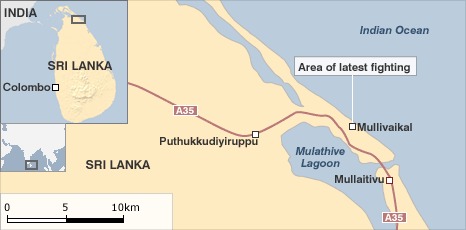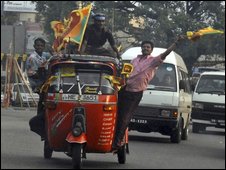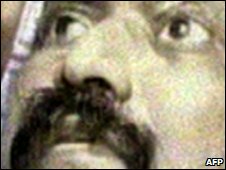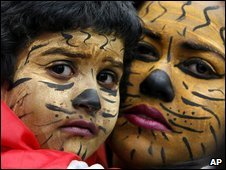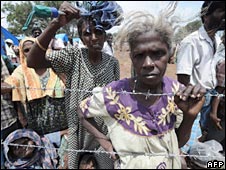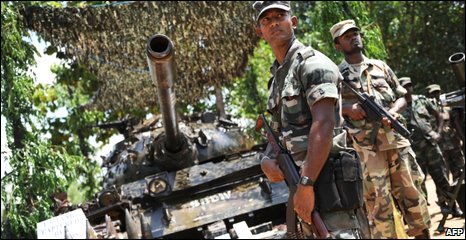- Reaction score
- 0
- Points
- 360
Here are some pics from the front just from a number of days ago, before the offensive resumed:

Sri Lanka's President Mahinda Rajapaksa (L) shakes hands with Army Commander Lieutenant General Sarath Fonseka after arriving in the northern town of Kilinochchi April 16, 2009 during a one-day visit to the defence force based in the war-torn north of the country. Sri Lanka's two-day humanitarian truce ended on Wednesday and the military announced it was now free to begin a final assault to end the 25-year war against the rebel Tamil Tigers. The Sri Lankan military says only 1,000 Liberation Tigers of Tamil Eelam (LTTE) rebels remain, and accuse the fighters of holding around 100,000 civilians as human shields. REUTERS/Sri Lankan Government/Handout

Sri Lankan soldiers stand next to a recaptured Liberation Tigers of Tamil Eelam (LTTE) tank and other weapons during a visit by Sri Lankan President Mahinda Rajapaksa to the defence force base in the northern Sri Lankan town of Kilinochchi April 16, 2009. Sri Lanka's two-day humanitarian truce ended on Wednesday and the military announced it was now free to begin a final assault to end the 25-year war against the rebel Tamil Tigers. The Sri Lankan military says only 1,000 LTTE rebels remain, and they accuse the fighters of holding around 100,000 civilians as human shields. REUTERS/Sri Lankan Government/Handout

Sri Lankan soldiers stand next to weapons they claim they had captured from the Liberation Tigers of Tamil Eelam (LTTE) forces during a visit to the defence force base by Sri Lanka's President Mahinda Rajapaksa in the northern Sri Lankan town of Kilinochchi April 16, 2009. Sri Lanka's two-day humanitarian truce ended on Wednesday and the military announced it was now free to begin a final assault to end the 25-year war against the rebel Tamil Tigers. The Sri Lankan military says only 1,000 Liberation Tigers of Tamil Eelam (LTTE) rebels remain, and accuse the fighters of holding around 100,000 civilians as human shields. REUTERS/Sri Lankan Government/Handout


A Sri Lankan soldier looks through a pair of binoculars while manning an anti-aircraft gun located atop a tower near the Presidential residence in central Colombo April 17, 2009. India asked Sri Lanka on Friday to extend a pause in war hostilities to enable civilians trapped in the conflict to leave for secure areas, saying the fate of Tamils could not be ignored.
REUTERS/David Gray (SRI LANKA MILITARY CONFLICT POLITICS)

An armed Sri Lankan policeman patrols along the seashore near the Presidential residence in central Colombo April 17, 2009. India asked Sri Lanka on Friday to extend a pause in war hostilities to enable civilians trapped in the conflict to leave for secure areas, saying the fate of Tamils could not be ignored.
REUTERS/David Gray (SRI LANKA MILITARY CONFLICT POLITICS)

A Sri Lankan naval boat crewman rests on a gun as it sails past another naval boat whilst they patrol the coastal waters off the city of Colombo April 19, 2009. Britain said on Saturday it was gravely concerned about fighting between government forces and Tamil separatists in Sri Lanka and had sent an envoy to the United Nations for urgent talks. Foreign Secretary David Miliband said the conflict in northern Sri Lanka threatened many thousands of civilian lives and repeated his call for an immediate ceasefire to allow civilians to leave the conflict area.
REUTERS/David Gray(SRI LANKA MILITARY CONFLICT POLITICS)

A Sri Lankan army soldier keeps guard at a checkpoint in Piliyandala suburb of Colombo on April 17. Sri Lankan security forces captured a defence line of cornered Tamil Tiger rebels on Monday and rescued at least 5,000 civilians being held as human shields, a military spokesman said. (AFP/File/Lakruwan Wanniarachchi)

Sri Lanka's President Mahinda Rajapaksa (L) shakes hands with Army Commander Lieutenant General Sarath Fonseka after arriving in the northern town of Kilinochchi April 16, 2009 during a one-day visit to the defence force based in the war-torn north of the country. Sri Lanka's two-day humanitarian truce ended on Wednesday and the military announced it was now free to begin a final assault to end the 25-year war against the rebel Tamil Tigers. The Sri Lankan military says only 1,000 Liberation Tigers of Tamil Eelam (LTTE) rebels remain, and accuse the fighters of holding around 100,000 civilians as human shields. REUTERS/Sri Lankan Government/Handout

Sri Lankan soldiers stand next to a recaptured Liberation Tigers of Tamil Eelam (LTTE) tank and other weapons during a visit by Sri Lankan President Mahinda Rajapaksa to the defence force base in the northern Sri Lankan town of Kilinochchi April 16, 2009. Sri Lanka's two-day humanitarian truce ended on Wednesday and the military announced it was now free to begin a final assault to end the 25-year war against the rebel Tamil Tigers. The Sri Lankan military says only 1,000 LTTE rebels remain, and they accuse the fighters of holding around 100,000 civilians as human shields. REUTERS/Sri Lankan Government/Handout

Sri Lankan soldiers stand next to weapons they claim they had captured from the Liberation Tigers of Tamil Eelam (LTTE) forces during a visit to the defence force base by Sri Lanka's President Mahinda Rajapaksa in the northern Sri Lankan town of Kilinochchi April 16, 2009. Sri Lanka's two-day humanitarian truce ended on Wednesday and the military announced it was now free to begin a final assault to end the 25-year war against the rebel Tamil Tigers. The Sri Lankan military says only 1,000 Liberation Tigers of Tamil Eelam (LTTE) rebels remain, and accuse the fighters of holding around 100,000 civilians as human shields. REUTERS/Sri Lankan Government/Handout


A Sri Lankan soldier looks through a pair of binoculars while manning an anti-aircraft gun located atop a tower near the Presidential residence in central Colombo April 17, 2009. India asked Sri Lanka on Friday to extend a pause in war hostilities to enable civilians trapped in the conflict to leave for secure areas, saying the fate of Tamils could not be ignored.
REUTERS/David Gray (SRI LANKA MILITARY CONFLICT POLITICS)

An armed Sri Lankan policeman patrols along the seashore near the Presidential residence in central Colombo April 17, 2009. India asked Sri Lanka on Friday to extend a pause in war hostilities to enable civilians trapped in the conflict to leave for secure areas, saying the fate of Tamils could not be ignored.
REUTERS/David Gray (SRI LANKA MILITARY CONFLICT POLITICS)

A Sri Lankan naval boat crewman rests on a gun as it sails past another naval boat whilst they patrol the coastal waters off the city of Colombo April 19, 2009. Britain said on Saturday it was gravely concerned about fighting between government forces and Tamil separatists in Sri Lanka and had sent an envoy to the United Nations for urgent talks. Foreign Secretary David Miliband said the conflict in northern Sri Lanka threatened many thousands of civilian lives and repeated his call for an immediate ceasefire to allow civilians to leave the conflict area.
REUTERS/David Gray(SRI LANKA MILITARY CONFLICT POLITICS)

A Sri Lankan army soldier keeps guard at a checkpoint in Piliyandala suburb of Colombo on April 17. Sri Lankan security forces captured a defence line of cornered Tamil Tiger rebels on Monday and rescued at least 5,000 civilians being held as human shields, a military spokesman said. (AFP/File/Lakruwan Wanniarachchi)














